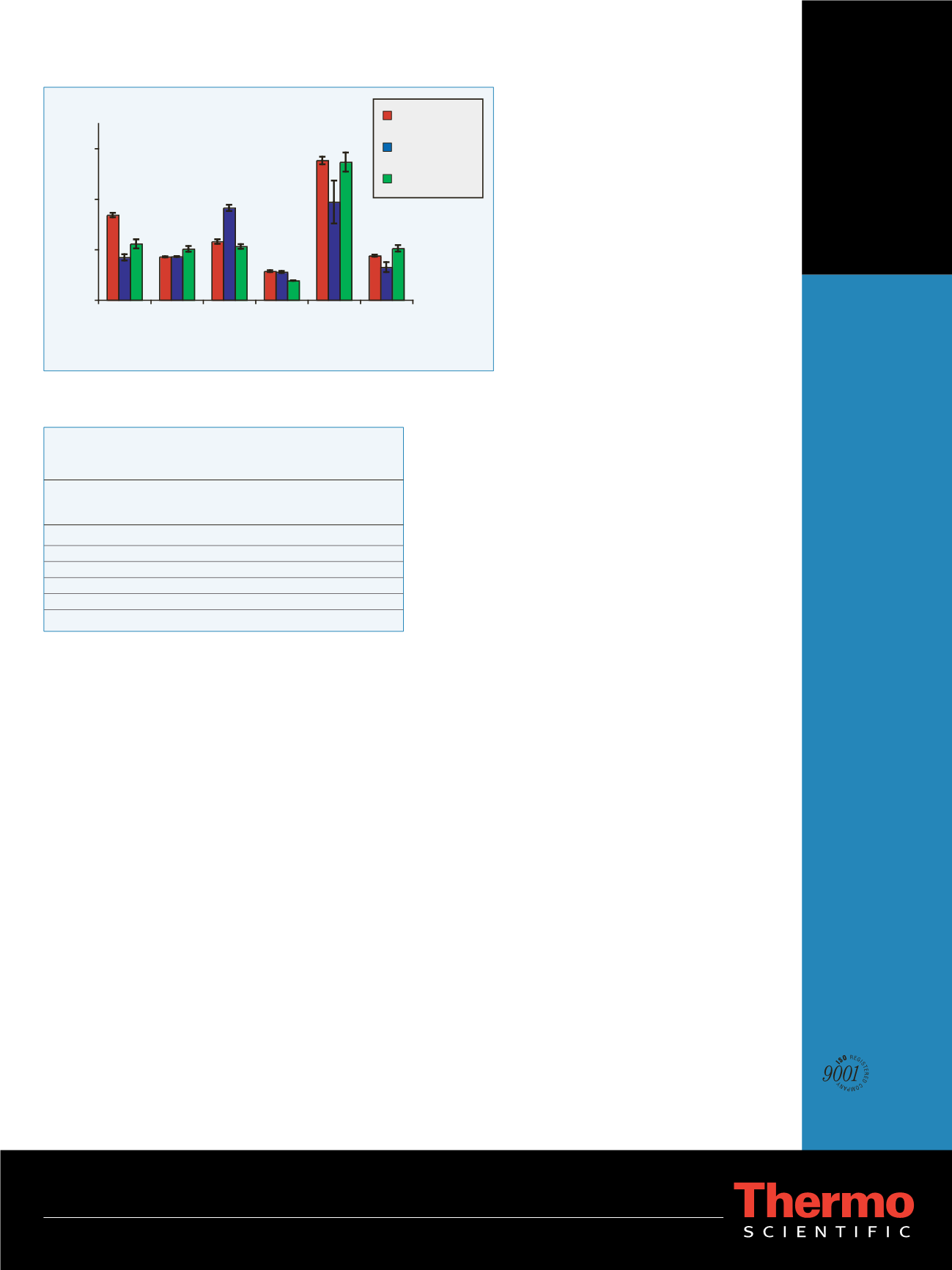

Conclusions
The developed analytical method allowed the extraction,
detection and quantification of six of the most used
anti-infectives in untreated and treated sewage. Detection
limits ranged from 0.3 to 22 ng L
-1
and instrument
response was linear (
r
2
≥
0.99) in the dynamic range
(25–1000 ng L
-1
). The use of two specific SRM transitions
and their peak area ratios proved to be a reliable and
effective way to reduce false positives and confirm the
presence of targeted substances. All the studied anti-
infectives were found in the wastewater samples in con-
centrations ranging from 39 to 276 ng L
-1
. More studies
are necessary to elucidate the fate of these anti-infectives
after they are discharged into the St. Lawrence River as
well as their effects on aquatic biota and the environment.
0
100
200
300
Sulfamethoxazole
Trimethoprim
Ciprofloxacin
Levofloxacin
Clarithromycin
Azithromycin
Concentration (ng/L)
North Influent
South Influent
Effluent
Figure 4: Occurrence of the studied anti-infectives in the dissolved phase of raw and treated
sewage of the City of Montréal (
n
=3)
Table 4: Removal efficiency of the Montréal wastewater
treatement plant and average mass flow of the studied
anti-infectives.
Mean mass flow in
the St. Lawrence
Compound
River (g day
-1
)
Sulfamethoxazole
340 ± 30
Trimethroprim
310 ± 20
Ciprofloxacin
320 ± 10
Levofloxacin
118 ± 2
Clarithromycin
830 ± 60
Azithromycin
310 ± 20
References
1
Kolpin D.W., Furlong E.T., Meyer M.T., Thurman E.M., Zaugg S.D.,
Barber L.B., and Buxton H.T. (2002)
Environmental Science & Technology
36
:1202-1211.
2
Hirsch R., Ternes T., Haberer K., and Kratz K.L. (1999)
Science of the
Total Environment
225
:109-118.
3
Metcalfe C.D., Koenig B.G., Bennie D.T., Servos M., Ternes T.A., and
Hirsch R. (2003)
Environmental Toxicology & Chemistry
22
:2872-2880.
4
Wilson B.A., Smith V.H., Denoyelles F., and Larive C.K. (2003)
Environmental Science & Technology
37
:1713-1719.
5
Richards S.M., Wilson C.J., Johnson D.J., Castle D.M., Lam M., Mabury
S.A., Sibley P.K., and Solomon K.R. (2004)
Environmental Toxicology and
Chemistr
y
23
:1035-1042.
6
Watts CD, Crathorne B, Fielding M, and Steel CP (1983)
Analysis of
Organic Micropollutants in Water
. D. Reidel Publishing Company,
Dordrecht.
7
Richardson M.L. and Bowron J.M. (1985)
Journal of Pharmacy &
Pharmacology
37
:1-12.
8
Hernandez F., Ibanez M., Sancho J.V., and Pozo S.J. (2004)
Analytical
Chemistry
76
:4349-4357.
AN62489_E 11/07S
Part of Thermo Fisher Scientific
Legal Notices
©2007 Thermo Fisher Scientific Inc. All rights reserved. All trademarks are the property of Thermo Fisher Scientific Inc. and its subsidiaries. This information
is presented as an example of the capabilities of Thermo Fisher Scientific Inc. products. It is not intended to encourage use of these products in any manners
that might infringe the intellectual property rights of others. Specifications, terms and pricing are subject to change. Not all products are available in all
countries. Please consult your local sales representative for details.
View additional Thermo Scientific LC/MS application notes at:
www.thermo.com/appnotesIn addition to these
offices, Thermo Fisher
Scientific maintains
a network of represen-
tative organizations
throughout the world.
Africa
+43 1 333 5034 127
Australia
+61 2 8844 9500
Austria
+43 1 333 50340
Belgium
+32 2 482 30 30
Canada
+1 800 530 8447
China
+86 10 5850 3588
Denmark
+45 70 23 62 60
Europe-Other
+43 1 333 5034 127
France
+33 1 60 92 48 00
Germany
+49 6103 408 1014
India
+91 22 6742 9434
Italy
+39 02 950 591
Japan
+81 45 453 9100
Latin America
+1 608 276 5659
Middle East
+43 1 333 5034 127
Netherlands
+31 76 587 98 88
South Africa
+27 11 570 1840
Spain
+34 914 845 965
Sweden/Norway/
Finland
+46 8 556 468 00
Switzerland
+41 61 48784 00
UK
+44 1442 233555
USA
+1 800 532 4752
www.thermo.comThermo Fisher Scientific,
San Jose, CA USA is ISO Certified.



















